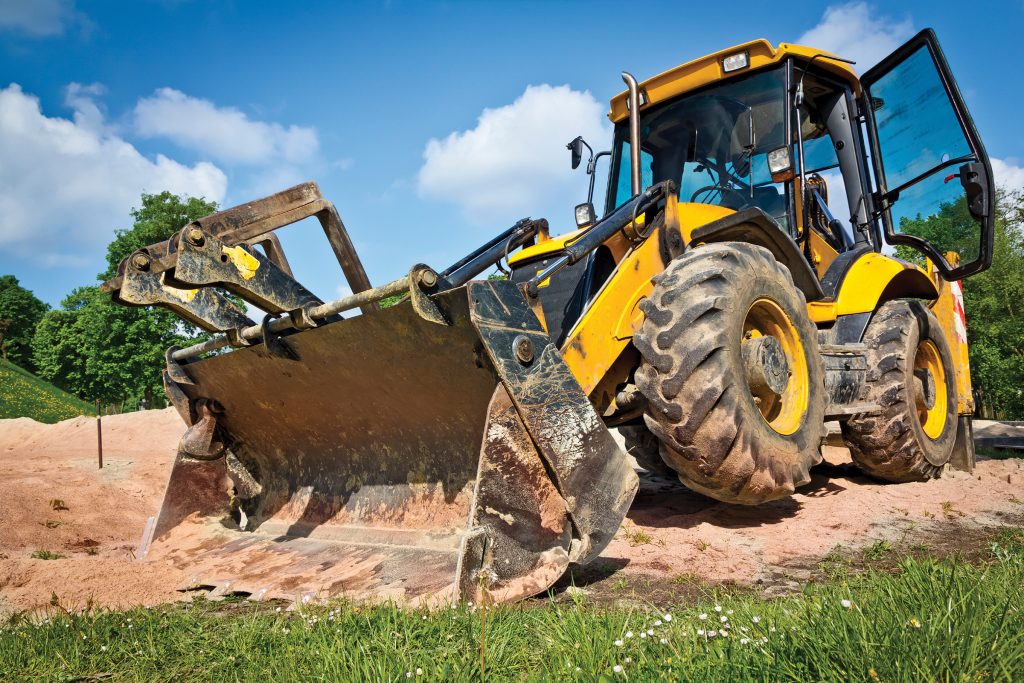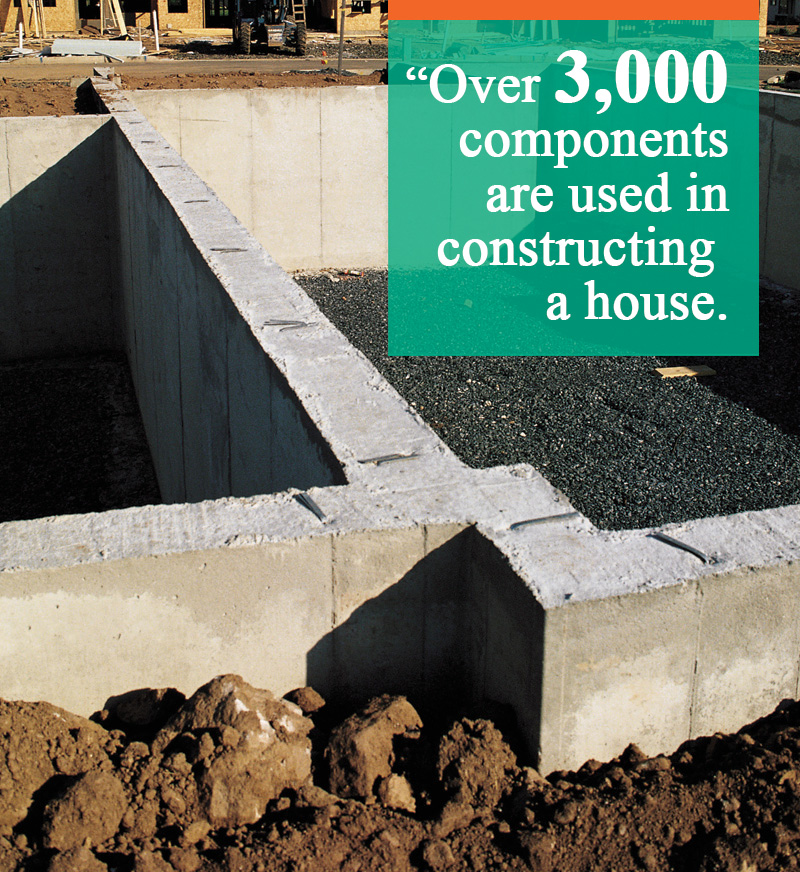 Did you know that there is a specially designated number you should call before starting any digging projects? 811 is the (free) phone number you need to call before digging to protect yourself and others from unintentionally hitting underground utility lines.
Did you know that there is a specially designated number you should call before starting any digging projects? 811 is the (free) phone number you need to call before digging to protect yourself and others from unintentionally hitting underground utility lines.
There are millions of miles of buried utilities beneath the surface of the earth that we don't even think about but are vital to everyday living like water, electricity and natural gas. By simply calling, you'll help prevent unintended consequences such as injury to you or your family, damage to your property, utility service outages to the entire neighborhood and potential fines and repair costs.
Most contractors know that they need to find out what’s underground before beginning to break ground, but there may be some finer points of safe digging that you’re not aware of.
How exactly does this 811 thing work?
Simply call 811 from anywhere in the country a few days prior to digging, and your call will be routed to your local call center. Tell the operator where you're planning to dig. Your affected local utility companies will be notified about your intent to dig and will send locators to your dig site to mark the approximate location of buried lines with flags or paint.
When can I begin my digging project?
Wait for the marks! Utilities will mark their buried lines on your dig site. Most crews will arrive to mark your dig site with paint or flags within a few days and will make sure you know where to avoid digging so you don't hit buried utilities. Remember there may be multiple utility lines in the same area. Be sure to check your state laws for specific information. It's also a good idea to call and confirm that all affected utility operators have responded to your request and located accurately. (State laws vary on the process for confirmation; check with your local one-call center for more information.)
It's finally time!
Now it's time to roll up your sleeves and get to work - but respect the marks! Make sure to always dig carefully around the marks, not on them. State laws generally prohibit the use of mechanized equipment within 18-24 inches of a marked utility, which is called the “tolerance zone”. If you must dig near the marks, hand dig or use vacuum excavation to expose the facility. After exposing the facility, avoid using mechanized equipment within the same tolerance zone.
The marks provided by the affected utility operators are your guide for the duration of your project. If you are unable to maintain the marks during your project, or the project will continue past your request’s expiration date, please call 811 to ask for a re-mark. In addition, if excavation equipment is removed from a work site for more than two (2) business days, you must notify the call center again.
Also keep in mind that some utility lines may be buried at a shallow depth, and an unintended shovel thrust can bring you right back to square one - facing potentially dangerous and/or costly consequences. Don't forget that erosion or root structure growth may shift the locations of your utility lines, so remember to call again each time you are planning a digging job. Safe digging is no accident!
Source: call811.com and ccicomply.net
 Let’s talk about you. Do you build at least 20 homes per year? Or do you build at least $2 million in sales volume?
Let’s talk about you. Do you build at least 20 homes per year? Or do you build at least $2 million in sales volume?
If you can answer yes to either question, have you considered joining our exclusive Incentive program?
The Incentive program is a great way for qualifying Members to effectively reduce their overall warranty costs by maintaining a high level of quality construction and customer service. Members receive “cash” back for a good claims record.
The idea behind the program is that if you have a good track record regarding claims issues for the 1st 5 years of your home enrollments, then the warranty company lets you “cash in” during the 2nd 5 years and earn back some of those premium dollars.
Both you and the warranty company chip in an initial minimum deposit to open up an Incentive account. Every time you enroll a home while in the Incentive program, the warranty company redirects a portion of the premium you’ve paid us into an account. As homes are enrolled, the fund grows. If you have a claim or hard-cost expenses (think Engineer’s structural inspection or geotechnical soils test) relating to a claim, we use this fund first – because those were insurance premium dollars that were being set aside rather than being paid to the insurer. If you don’t have a claim, the fund just keeps on growing.
Then beginning in year 6 and continuing through year 10, you start to receive checks back from us based solely on your own claims experience. It’s like betting on your own track record that you won’t have serious major structural defects in your homes.
If you have claims, you haven’t lost anything because you’ve paid the exact same rate that you were paying before joining the Incentive program. If you don’t have claims, you “cash in” and stand to get back up to 15% of your premium dollars.
After the first year, we’ll even waive your annual registration fee of $295 for every year that you participate in the program. That saves $1180 for your bottom line over the first 5 years even if you never get one penny back in distributions. It’s pretty much a win-win proposition.
So again I say, let’s talk about you. Can we help you cash in? Call us today at 800-247-1812, Ext 2149 for a free, no obligation illustration based on your company’s numbers and let’s see if we can help you benefit a little more from your good customer service.
 Ah, fall is the air. Are you ready for brilliantly colored leaves, pumpkin flavored treats, apple cider, or, ARE YOU READY FOR SOME FOOTBALL? George Will once said, “Football combines the worst two things about America: violence punctuated by committee meetings”. What that means is that for the next five months many Americans who tune in to NFL games will be watching a lot of TV but, in actuality, very little football. Several studies including one by the Wall Street Journal have calculated that although an NFL game lasts about 3 hours and 12 minutes there are only a mere 11 minutes of actual play time that takes place. Why is that? One big culprit is the rules. The paperback version of the NFL rulebook is close to 300 pages in length and filled with rules and regulations that address almost every possible scenario that could take place during a game. And while the rules may seem excessive and overbearing, they serve to ensure the uniformity, integrity, and safety of the game and its players.
Ah, fall is the air. Are you ready for brilliantly colored leaves, pumpkin flavored treats, apple cider, or, ARE YOU READY FOR SOME FOOTBALL? George Will once said, “Football combines the worst two things about America: violence punctuated by committee meetings”. What that means is that for the next five months many Americans who tune in to NFL games will be watching a lot of TV but, in actuality, very little football. Several studies including one by the Wall Street Journal have calculated that although an NFL game lasts about 3 hours and 12 minutes there are only a mere 11 minutes of actual play time that takes place. Why is that? One big culprit is the rules. The paperback version of the NFL rulebook is close to 300 pages in length and filled with rules and regulations that address almost every possible scenario that could take place during a game. And while the rules may seem excessive and overbearing, they serve to ensure the uniformity, integrity, and safety of the game and its players.
Rules impact nearly every aspect of our lives. We can’t get away from them, nor should we. There are rules for governance, conduct, mathematics, grammar, driving, even cooking and the list goes on and on. It is fair to say that without rules there would be anarchy. Rules provide a society with structure and accountability. As a builder or manufacturer, you too are subject to a unique set of rules that address every aspect of your homebuilding from development through settlement. And, if the rules aren’t followed, there can be big problems. Without proper site preparation, foundations can fail. Without proper flashing, homes will leak. Without proper placement of beams, loads won’t be supported. Without proper spacing between joists, floors will sag. And this list too goes on and on.
The good news is that if you are an RWC, HOME of Texas and/or MHWC member builder, only the best of the best are accepted into their program…builders/manufacturers that follow the rules. Your homebuyers can be assured that you have met the company's high standards of quality workmanship, financial stability, and ethical customer dealings. And, then there’s the rulebook…The Limited Warranty Agreement. Your homeowners are given a set of rules, in writing, that explains what’s acceptable, what’s not and what steps to follow. What a great way to show them your integrity and how much you care about the product you deliver. Vince Lombardi once said, “Perfection is not attainable, but if we chase perfection, we can catch excellence”.
 A simple number can really give you perspective. Perhaps you were on the fence about doing more remodeling? Or are trying to brainstorm ideas for a fresh take on the homes you build? Consider these numbers and be inspired to try that new kitchen design or implement features in your homes for the aging population, for example. ...Or simple impress your colleagues with some fun industry facts!
A simple number can really give you perspective. Perhaps you were on the fence about doing more remodeling? Or are trying to brainstorm ideas for a fresh take on the homes you build? Consider these numbers and be inspired to try that new kitchen design or implement features in your homes for the aging population, for example. ...Or simple impress your colleagues with some fun industry facts!
3.5 PERCENT
Percentage of current housing stock that offers all three of these features to support independent living for an aging population: zero-step entrances, single-floor living, and wide halls and doorways.
1901 SQUARE FEET
Average U.S. home size, which is nearly 30% larger than European homes, but smaller than the Australian average of 2032 sq. ft.
$3.1 BILLION
Size of the kitchen and bath remodeling industry.
60 PERCENT
The percentage of contractors that said the number one way to drive up costs is when homeowners ask for changes after a project begins. These changes increase the cost by an average of 10 percent.
When most insurance agents hear the RWC Insurance Advantage offers Claims-made general liability coverage, they warn their general contractor customers to stay away from it. They say you’ll be trapped by the “gap” in coverage that will open up the moment you try to leave. What happens upon termination of coverage is one of the biggest arguments against Claims-made. The way some agents talk, you’d think Claims-made is like the old children’s poem “The Spider and the Fly;” “Will you walk into my parlor?’ said the Spider to the Fly.” We know the fly enters - never to leave. These agents argue there would be no coverage for any claim made after policy termination even if the loss occurred during the time the policy was in force. And they would be right – with any other company’s Claims-made policy. Those companies will offer you a Supplemental Extended Reporting Period, or SERP, at the end of your policy term when you try to move your coverage to another company. They will charge you up to 200% of your expiring policy’s premium for the SERP. Who can afford that and the new policy premium as well?
This WILL NOT HAPPEN with the RWC Insurance Advantage’s unique Claims-made policy. With our policy, the SERP is offered UP FRONT, and we GUARANTEE that it will be attached, as long as your policy is not canceled for non-payment of premium. Rather than charge a large lump sum at the end for the SERP, we add a reasonable 25% charge to each policy term, and you have 6 years to pay it off. After that, the SERP is fully funded and we GUARANTEE it’s attachment at policy termination - no matter what. Even better, if you decide to leave before the 6 years are up you’ll still get the SERP - and NO COVERAGE GAP.*
The SERP is unlimited in duration and can never be canceled for any reason. It automatically restores limits that may have been used up by prior claims. Even if you decide to move your general liability coverage somewhere else after just one year with the RWC Insurance Advantage, you’ll still get the SERP – guaranteed.
So, walk into our parlor anytime without fear of being trapped. Call us at (866) 454-2155 and ask for Ron Sweigert or click here for a free no obligation quote.
(*Subject to short rate premium penalty if you cancel your current policy before its expiration date.)
 As the economy continues to improve, builders are gaining more and more confidence in their business' future. Tides are shifting from builders only treading water to keep their company afloat, to moving forward and expanding profit margins.
As the economy continues to improve, builders are gaining more and more confidence in their business' future. Tides are shifting from builders only treading water to keep their company afloat, to moving forward and expanding profit margins.
The number one cost for builders is direct construction expenditures. Simply reducing costs, even modestly, and strategizing ahead of time will unmistakably help you reach your goals.
Check out the following suggestions and tips and implement them into your business plan to maximize your bottom line.
- Design your new models to attain a predetermined direct construction percentage rate based on the anticipated sales price. A model will not be acceptable if it exceeds a recommended percentage.
- Consider the cost of the lot to determine “how much” house you can build.
- Identify base-model features that can be replaced with more economical items without reducing the home’s appeal. Include input from subcontractors and suppliers about potential cost reductions including design alternatives and worker efficiency.
- Include all options and upgrades within each job’s budget.
- Determine the target gross profit as a component of the budget before starting a project.
- Avoid estimating by square footage. Unless the materials are identical, the site work known, and weather conditions constant, pricing by square foot often leads to inaccurate quotes and underpriced bids.
- Keep the specs simple. Too many options will limit the number of potential buyers.
- Re-estimate immediately after completing the first unit of a new plan to evaluate if additional costs should be considered for subsequent units.
- Create detailed direct construction budgets on model/display homes, just as you would with any other home. Display homes tend to evade the normal budgeting process, leading to higher costs and reduced profits when ultimately sold.
- Perform periodic walkthroughs to control costs and ensure materials are being used as intended. Project managers, superintendents, estimators, and designers should all participate in walkthroughs.
- Develop strong relationships with a select group of subcontractors and suppliers. Constantly switching subs and vendors in search of minor savings can be counterproductive. Try to work with your regular subs and vendors to find savings together.
- Schedule together with your key subs. This will result in a much more accurate schedule than if you created it yourself, and the subs will feel more responsibility to meet their milestones.
- Change orders should be documented using only written forms. This allows both you and the buyer to sign the change order, which should list the change, adjusted total price, and necessary schedule revisions.
- Don’t be afraid to raise prices, especially in a good market. As your costs increase, many of these should be reflected in the sales price. A regular price increase program should be in place.
Source: nahb.com
Why is it important to worry about safety when it comes to wet concrete? Because concrete is one of the most widely used construction materials there is, which means there are an untold number of workers who are exposed to these hazards on a daily basis. The biggest hazards include skin irritation, severe chemical burns, and serious eye irritation. Concrete can be safe when used appropriately and with the safety precautions below.
- Wet cement (an ingredient in concrete) is caustic, abrasive and drying, so protect your skin. Wear appropriate PPE such as tall rubber boots, pants, waterproof gloves and long-sleeved shirts.
- If concrete comes into contact with your skin, it’s important to immediately wash off with clean water and replace any wet clothing or PPE. Don’t wait!
- Be sure to wear eye protection when working with wet concrete. Your eyes can be seriously injured due to splashing concrete. Wear safety glasses with side shields or safety goggles.
- Wet concrete can conduct electricity. All electric tools should be grounded and used with care.
- When raising or lowering concrete chutes, be aware of pinch points. These can take off a finger or hand if you’re not paying attention.
- Protect your back. Place wet concrete via chute, wheelbarrow or pump, as close to the work area as possible. Concrete should be pushed, not lifted, into place.
- Use waterproof kneepads or a dry board when kneeling to place or finish concrete.
It’s important to understand that you may not experience any acute symptoms right away if wet concrete touches your skin. But if you don’t wash the area as soon as possible with cold, clean water, you could end up with a serious burn. If a burning sensation continues or worsens even after you’ve flushed the area with water, seek medical attention. If wet concrete splashes into your eyes, flush them continuously with clean water for at least 15 minutes and then go to the hospital.
Source: www.ccicomply.net
Occasionally we will highlight a section of the warranty book just as a reminder of how things work or to demonstrate protections built into the warranties. This time, we thought a reminder of all the various warranty options available to you by virtue of your RWC membership might be helpful.
Let’s start off here: http://www.rwcwarranty.com/builders/whats-covered/. As an RWC Member, you have choices galore!
You can have a warranty with Major Structural Defect coverage or a warranty with coverage on Designated Structural Elements. You can have coverage that includes workmanship, materials, mechanical systems and structural components or you can pare it down to one that just covers structural components. You can stick to the traditional FHA/VA approved 10-year variety or customize it with a warranty that mirrors your state’s statutes.
That covers the “new home” variety of warranties. But we know that many builders out there do much more that build new homes. They remodel, they convert commercial structures into condos, they may build a detached garage and on and on.
That being said, check out the RWC Menu of Choices at rwclive.wpengine.com/builders/warranty-options/
- RemodelerWarranties with options to fit the job (and in states like Indiana & Minnesota, to meet state statutes as well)Commercial Warranties
- Conversion Warranties
- Building Systems Warranties
- HUD-Code Manufactured Home Warranties
- Appliance & Systems Extended Warranties*
- 1 Year Renewable Warranties
- Commercial Insurance Products (GL, Builder’s Risk, and Contractor’s Equipment)
*Available in select states only at this time.
We’re working hard to meet the needs of our Membership. If you have a need for a warranty and we don’t have a product to meet that need, let us know and we’ll look into it. We’re always on the lookout for ways to better serve our Members!
 Building homes is a very complex thing. The National Association of Home Builders estimates that over 3,000 components are used in constructing a house. The single most problematic component for Residential Warranty Company, LLC (RWC) is the foundation, a wall of concrete block resting on a footing, supporting the full weight of the house, its contents, and inhabitants. This component is arguably the most important component. Why then is it the most problematic?
Building homes is a very complex thing. The National Association of Home Builders estimates that over 3,000 components are used in constructing a house. The single most problematic component for Residential Warranty Company, LLC (RWC) is the foundation, a wall of concrete block resting on a footing, supporting the full weight of the house, its contents, and inhabitants. This component is arguably the most important component. Why then is it the most problematic?
When designing and constructing a concrete block (CMU) foundation there are many very important elements that need to be considered. The single biggest dynamic that we are faced with is resistance to lateral movement. The forces that laterally impact CMU foundations should be considered when using this method of foundation construction. Steel reinforcement, introduction of pilasters, solid grout along with rebar in hollow cores and attention to backfill and soil types go a long way in constructing an adequate foundation wall that can resist lateral forces.
There are external factors that can affect CMU foundation performance. The height of the backfill along with the type of soil (clay, shale, sandy, expansive, etc.) may have required special attention when it was placed. The installation of perimeter drain systems whether internal or external will be evaluated. Is a sump pump installed and has the homeowner been proactive in using and maintaining the system? If the system is day lighted, is the line clear and does it function properly? Hydrostatic pressure created from over saturated soil has tremendous weight that can test the limits of the foundation wall if a potential water condition is not mitigated.
When a claim is made to RWC, a fact-finding inspection is ordered. A licensed professional engineer is scheduled to visit the home and assess all aspects of the condition reported. RWC will contact you and ask for any documentation you have regarding the construction of this home. If upon review of the fact-finding inspection report in relation to the Limited Warranty applicable to the home, the condition of the defect meets the specified criteria for coverage, RWC is obligated to take action. In most instances the mode of foundation movement is lateral and our responsibility is to restore the load-bearing function of the foundation wall. The engineer will evaluate the unbalanced fill condition as he evaluates the foundation wall. Any actions that the homeowner may have taken regarding landscaping, patio installation, modifications to the downspout locations or re-routing of the downspouts along with overall grading and drainage that may have been modified after the home was delivered by the Builder, are noted and taken into consideration.
During this phase of the claim, RWC will again reach out to your company. As the Builder, you have the most knowledge about this home. You have been intimate with this structure from the first idea that a home should be constructed until settlement changes title to your buyer. We understand and respect that you are most knowledgeable. We rely on your expert knowledge and ask that you provide us with the details regarding how this foundation was designed and built. This will include requests for drawings and details regarding any service orders or warranty claims that you have dealt in the first two years of the homes life. Anything that you can provide to us so we can carefully evaluate every aspect of this covered condition.
RWC will be required to provide a settlement offer, or in some cases, make repairs that will restore the load-bearing function to the CMU foundation. We are not obligated to rebuild the foundation wall however this may be necessary dependent on the severity of the lateral displacement. Our efforts commonly involve reinforcement utilizing solid core grouting and rebar installation and more recently the use of carbon fiber reinforcement. This work is most often performed from the interior of the home negating the extensive cost of exterior excavation. It is important to recognize that this work will be accomplished in accordance with a sealed structural repair plan provided by a licensed engineer and the work will be certified at completion by the same professional. Remember, the Limited Warranty requires that the load-bearing function be restored, that does not necessarily mean that a wall that shows signs of lateral movement needs to be plumb when the repairs are complete.
RWC understands that you are truly professional Builders. When we have to deal with this significant structural problem we know you have done your due diligence throughout the construction process and you will be able to provide us with the important data we need to ensure a fair evaluation of the claim and an adequate repair when required.
Written by Don Sechler, RWC Warranty Resolution
